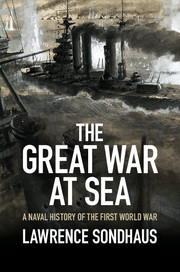Book contents
- Frontmatter
- Contents
- List of figures
- List of maps
- Acknowledgments
- Introduction
- 1 Ambition, ideology, and arms races
- 2 Preparing for war
- 3 Global prelude
- 4 European waters, 1914–15
- 5 Submarine warfare: The great experiment, 1915
- 6 Combined operations, 1915
- 7 The year of Jutland: Germany’s fleet sorties, 1916
- 8 Submarine warfare: The great gamble, 1917–18
- 9 War and revolution, 1917
- 10 Final operations
- Conclusion: Peace and naval disarmament
- Bibliography
- Index
- References
Conclusion: Peace and naval disarmament
Published online by Cambridge University Press: 05 August 2014
- Frontmatter
- Contents
- List of figures
- List of maps
- Acknowledgments
- Introduction
- 1 Ambition, ideology, and arms races
- 2 Preparing for war
- 3 Global prelude
- 4 European waters, 1914–15
- 5 Submarine warfare: The great experiment, 1915
- 6 Combined operations, 1915
- 7 The year of Jutland: Germany’s fleet sorties, 1916
- 8 Submarine warfare: The great gamble, 1917–18
- 9 War and revolution, 1917
- 10 Final operations
- Conclusion: Peace and naval disarmament
- Bibliography
- Index
- References
Summary
“This treaty ends, absolutely ends, the race in competition in naval armament,” Charles Evans Hughes assured the assembled audience, presenting the final draft of the Washington Naval Treaty. “At the same time it leaves the relative security of the great naval powers unimpaired.” It was the crowning achievement in the career of one of the most talented American leaders never to serve as president, and a moment filled with irony. Hughes, former governor of New York and Supreme Court justice, had been the Republican nominee for president in 1916 and only narrowly lost to Woodrow Wilson. Now, in February 1922, as secretary of state in the isolationist administration of President Warren G. Harding, he had the honor of presenting the product of negotiations he had conducted over the previous three months in the spirit of the fourth of Wilson’s Fourteen Points, which had called for disarmament “to the lowest point consistent with domestic safety.” Coming after the reduction of the German navy by the Treaty of Versailles and the virtual destruction of the former tsarist fleet in the Russian civil war, the Washington conference of 1921–22 completed the cycle of naval disarmament, reducing by negotiation the fleets of the five remaining naval powers: Britain, the United States, Japan, France, and Italy.
The course of the Great War at sea had confirmed the deterrent capacity of capital ships, and that they did not have to be risked in combat in order to have strategic relevance. As a consequence, just ten were sunk during the war, of which four were lost in port by accident or sabotage, joined by two more, one Russian and one Austro-Hungarian, sunk after those navies had stopped fighting. Thus, at war’s end, 116 of the 128 capital ships commissioned by the eight largest belligerent navies since HMS Dreadnought in December 1906 remained afloat, far more than anyone could justify maintaining in peacetime. But as the peace conference opened at Paris, no one would have predicted that, just three years later, at Washington, a treaty would be signed imposing tonnage quotas that, as initially applied, allowed the five leading navies combined to maintain just sixty-three capital ships.
- Type
- Chapter
- Information
- The Great War at SeaA Naval History of the First World War, pp. 352 - 370Publisher: Cambridge University PressPrint publication year: 2014



